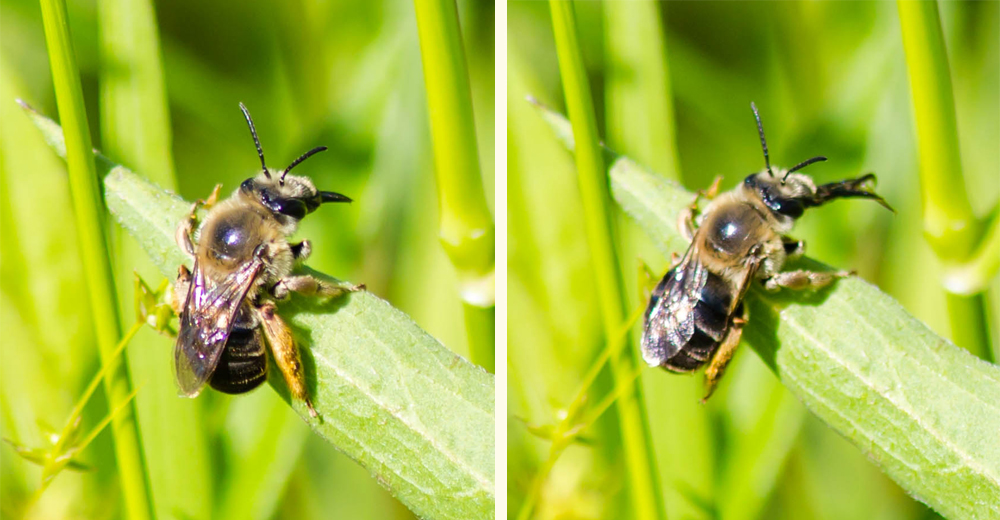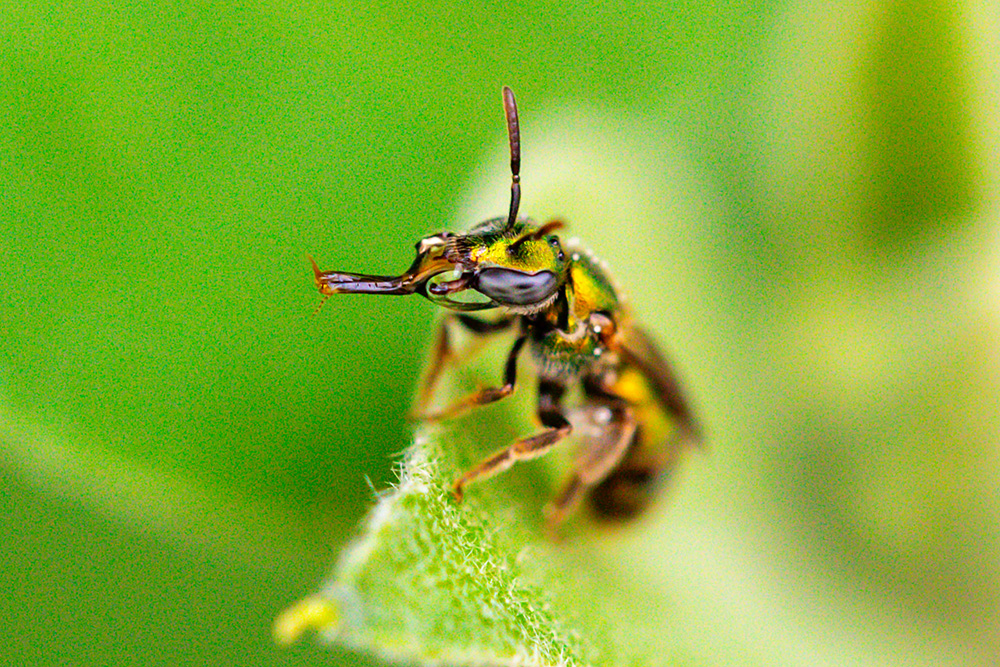NatureZen: Speaking in Tongues
words and photos by Melissa McMasters
If you’re the sort to make New Year’s resolutions, now is the time to grudgingly start thinking about your plans for self-improvement. A few years ago, I set two goals for myself, thinking that if past was prologue, they were both pretty unrealistic. One: do a complete pushup without collapsing in a heap midway through. (Still waiting on that one!) Two: see, and perhaps even photograph, a bee tongue. I’d been thinking about sweat bees, and how they’re so named because they lick salty sweat from people’s bodies. And yet I’d never seen one’s tongue. I couldn’t even contemplate how tiny one must be.
Perhaps because I put more time into nature observation than I do into strengthening my core, I was surprised at how much more easily I accomplished this second goal. But the universe of bee tongues (and indeed, insect tongues in general) was far more complex than I expected. Here are just a few glimpses into the nitty-gritty of pollination.
As humans, we’re used to seeing tongues with pretty simple structures–dogs, cats, ourselves. As far as insects go, we’re probably most familiar with butterflies, which have a long proboscis that curls and uncurls, retracting beneath their heads when they aren’t feeding.

Its ability to curlicue aside, this tongue looks pretty simple, right? But when we zoom in, we can see that instead of a one-part structure, butterfly tongues actually have two tubes alongside each other, with a canal in the middle that sucks up the nectar. Muscles in their heads connected to this canal help pull the nectar upwards.

Many flower flies have a short “tongue” that extends from beneath their heads, and it’s tipped with a sponge-like structure that soaks up nectar and pollen.

As with butterflies, you’ll notice a lengthy proboscis on bee flies (which are non-stinging members of the fly family that disguise themselves as bees to ward off predators). Unlike butterflies, they can’t retract their tongues, so they always appear to be leading with a spear when they approach. (But fear not–those tongues are used for lunch, not war.)

Butterflies and bee flies often have their tongues on display. But seeing bee tongues wasn’t so simple. At first, I was thrilled just to get photos of bees taking nectar, like this denticulate longhorn bee. His tongue is constructed just for this type of flower, since he specializes on ironweed plants. But this kind of photo doesn’t tell me much about the tongue’s structure. For that, I realized I needed to find the bees when they weren’t actively feeding.

This bumble bee was taking a break from nectaring, which allowed me to watch it fold its mouthparts back up under its body. This is where I have to switch to “mouthparts” instead of “tongue,” because this is quite an intricate structure! The actual tongue (called the glossa) is contained within two hard sheaths (called the galea) that close around it. You can see the sheaths in this photo, along with the brushy tip of the bee’s glossa emerging from inside.

Within or alongside the galea are two other, softer tubes called the labial palps that help the bee taste and feel. You can see the galea separated in this photo of an Eastern thistle longhorn bee, with the glossa extending downward.

All of these mechanisms are hidden away until the bee fully opens its mouthparts, as this Eucera longhorn bee is doing. (The second photo is a little blurry because I had never seen this happen before, and apparently saying, “Wait, WHAT?!” while pressing the shutter results in camera shake. I am a true professional.)

It’s fitting, given how my curiosity about this subject started, that my favorite bee tongues to watch have belonged to sweat bees. I caught this striped sweat bee cleaning its tongue while resting in a Mexican petunia flower. In the first photo, everything is retracted. In the second photo, the bee has opened its mandibles (the yellow hinges on either side of its mouth), and by the third photo it’s sticking out its tongue…

…but maybe not all the way out. Some bees have a shorter glossa than others, but they still need to obtain nectar from longer-bodied flowers. Bees in the Agapostemon genus, like this striped sweat bee, evolved long hinges to extend their reach. You can see here that the actual glossa (black with a brushy red tip) is not particularly long, but the hinges give the bee almost double the probing power! And as in the image above, they simply fold up under the bee’s head when not in use.

Finally, here’s a golden augochlora sweat bee I saw in Texas last month offering a thorough look at the whole system. It’s truly incredible what’s going on inside a bee’s jaws!

This is a tremendously oversimplified look at the structures some insects use to pollinate flowers, and I hope to keep exploring and understanding in greater detail how insects and flowers work together. If you’re interested in a deeper dive into bee biology, I recommend this Museum of the Earth link!



